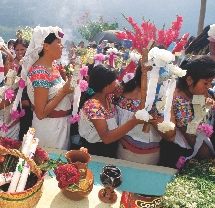Biological Battle
Without realizing it, the Spaniards brought a germ to Mexico. It caused smallpox, a deadly disease. The germ soon infected the Aztec.
Smallpox hadn’t existed in Mexico. That meant the Aztec had no immunity, or resistance, to it. The disease spread quickly through the population, killing tens of thousands of Aztec.
Weakened by illness, the Aztec couldn’t harvest their crops. So even more people died of hunger. Sick, hungry, and unable to defend themselves, the Aztec finally lost to the Spaniards in 1521.
That defeat ended the Aztec Empire, and Mexico became part of New Spain. Yet the Aztec influence lived on.
The Mexican Mix
After 1521, Mexico slowly developed a new culture. This new culture was neither Aztec nor Spanish. It was both!
For example, most Spanish were Catholic and celebrated the holidays of All Saints’ Day and All Souls’ Day in November. At about the same time of year, the Aztec performed special rituals for their ancestors.

Mexicans celebrating the Day of the Dead today
Before long, a new Mexican holiday formed. It was called Día de los Muertos, or Day of the Dead. This holiday honors ancestors and the spirits of loved ones. Today, the Day of the Dead is a national holiday in Mexico.
You can also taste that mixed culture in the food we eat today. A good example is the taco. The shell is made of corn, an Aztec crop. Inside you might find beef and cheese, products that came to the Americas with the Spaniards.
Of course, a taco is just a small example of how cultures can blend. Each situation is different. Mexico’s culture clash sparked warfare. Sometimes, though, cultures meet and mix peacefully. Whatever happens between cultures, the result will be both challenging and interesting.